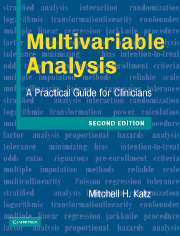Book contents
- Frontmatter
- Contents
- Preface
- 1 Introduction
- 2 Common uses of multivariable models
- 3 Outcome variables in multivariable analysis
- 4 Type of independent variables in multivariable analysis
- 5 Assumptions of multiple linear regression, multiple logistic regression, and proportional hazards analysis
- 6 Relationship of independent variables to one another
- 7 Setting up a multivariable analysis
- 8 Performing the analysis
- 9 Interpreting the analysis
- 10 Checking the assumptions of the analysis
- 11 Propensity scores
- 12 Correlated observations
- 13 Validation of models
- 14 Special topics
- 15 Publishing your study
- 16 Summary: Steps for constructing a multivariable model
- Index
3 - Outcome variables in multivariable analysis
Published online by Cambridge University Press: 05 July 2011
- Frontmatter
- Contents
- Preface
- 1 Introduction
- 2 Common uses of multivariable models
- 3 Outcome variables in multivariable analysis
- 4 Type of independent variables in multivariable analysis
- 5 Assumptions of multiple linear regression, multiple logistic regression, and proportional hazards analysis
- 6 Relationship of independent variables to one another
- 7 Setting up a multivariable analysis
- 8 Performing the analysis
- 9 Interpreting the analysis
- 10 Checking the assumptions of the analysis
- 11 Propensity scores
- 12 Correlated observations
- 13 Validation of models
- 14 Special topics
- 15 Publishing your study
- 16 Summary: Steps for constructing a multivariable model
- Index
Summary
How does the nature of my outcome variable influence my choice of which type of multivariable analysis to do?
As shown in Table 3.1, the choice of multivariable analysis depends primarily on the type of outcome variable that you have.
What type of multivariable analysis should I use with an interval outcome?
With an interval variable (also called continuous) each unit (interval) of change on the scale has an equal (numerically) quantifiable value. Examples of interval variables are blood pressure, body weight, and temperature. In these examples, a one-unit change at any point on the scale is equal to a millimeter of mercury, a pound (or kilogram), or a degree, respectively.
Interval outcomes can be analyzed with multiple linear regression or with analysis of variance. Either technique will yield the same answer, assuming you set up the models in similar ways. In general, multiple linear regression is more commonly used with observational data, and analysis of variance is more commonly used with experimental designs. Multiple linear regression is more commonly used in the medical literature, and analysis of variance is more commonly used in the behavioral literature.
Because multiple linear regression is easier to explain, easier to set up correctly, and easier to interpret than analysis of variance, I have focused on this technique in this text.
- Type
- Chapter
- Information
- Multivariable AnalysisA Practical Guide for Clinicians, pp. 24 - 34Publisher: Cambridge University PressPrint publication year: 2006

